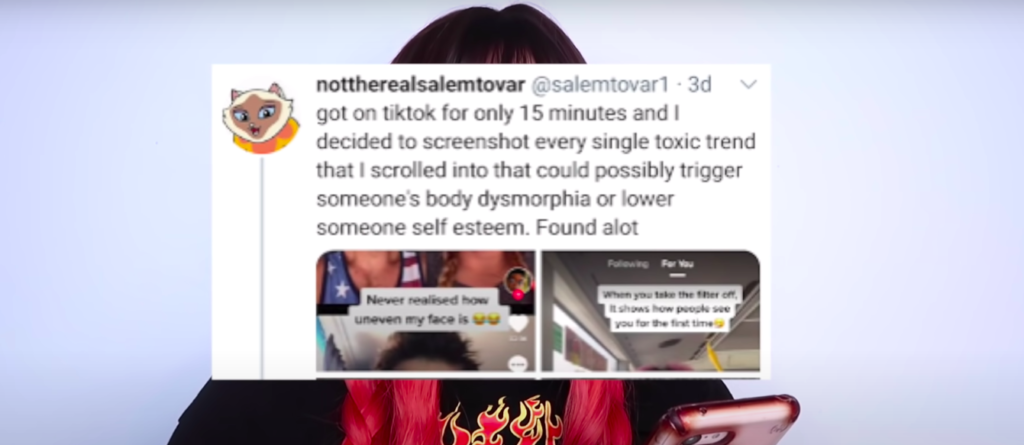Who is responsible for lowering people’s self-esteem: People or TikTok?
Content Creator, Salem Tovar, within 15 minutes of using the app, noticed 3 videos about body standards, later a total of 10. Tovar quoted on her Twitter, “this can possibly trigger someone’s body dysmorphia or self-esteem”.

Tiktok is a word-wide and viral app with the purpose of being educational, to spread awareness and information. In Apr. 2020, Sensor Tower reported that the app is downloaded more than 2 billion times in Apple App Store and Google Play. Doubling its number of downloads in just over a year and has stayed in the top 10 charts for being the most used app (2019-2020).
An average of 100 million people joins and create videos every day. Unlimited content of scrolling through others’ videos and the algorithm greatly contributes to Tik Toks’ success of being an addictive media entertainment platform. TikTok’s algorithm works to study the user in what interests them the most. After a decent amount of information, the algorithm will continue to give the same content to attract its user. While scrolling through, one might stumble across a toxic trend.
However, many trends have given the opportunity for creativity to shine to a larger audience. It has also given young people a career, for every 1000 views from a video, they will earn a certain amount that may multiply greatly from person to person.
“The community has a lot to offer with TikTok having a side of wholesomeness or cute, from all sides….Users can cultivate their culture, interest, etc…Overtime the ideal body to have been changed through centuries by influencers and social media projecting these ideas trough trends,” said Inaara Gangji, who studies social marketing, and a user of TikTok.
Platforms are powered by likes, comments, and shares that will show up in people’s feeds. There was a reported case brought to the European Union (EU) of companies who were collecting data about people, at the same time they did not pay enough attention causing fake news to spread on social media through paid sponsorships.
An example of a toxic trend is where girls would wear an oversized t-shirt then pulling back the fabric to reveal a clear body figure. Although the videos have no intentions of body-shaming, all the comments are full of negativity. From comments saying lower self-esteem, lower confidence, and hatred of one’s body shape.
Another example is when a girl is crying while doing a “beauty” trend; this uses a filter that mirrors your face to see if it is symmetrical. Videos of girls are seen to be devastated after not having a symmetrical face and doing other toxic beauty trends. Some users have argued that they are kids or acting immature, but trends like these can be mentally damaging for a long period of time.
“Research studies that show that there are [people] 100% impacted their perceptions are impacted actions in real life are impacted by what they see in the media,” added Gangji.
Beauty standards are obsessions over time of peoples’ likes and opinions. One Tik Tok user (@benthamite) has exposed the apps’ beauty algorithm. The artificial intelligence or program prefers those who have Asian or European features from its studies. Determining if an individuals’ account is virality worthy. Explained by Salem Tovar.
“People are more likely quote-unquote watch something that I guess is more attractive to them in the way society’s beauty standards are, rather than something not so conventional in their eyes. Maybe, something they aspire to look like,” said Gangji.
This is problematic since people who have filled the standard have the upper hand over those who are the opposite of these standards, who will take a longer time to reach the title of ‘viral’. Tik Toks’ algorithm is partly responsible for its purpose of spreading the video whether good or bad.
The advertisements on social media add more to the issue of young teens who may already struggle with the body they have. Many have tried “perfect” beauty to ideals, only to damage themselves even further. Removing negative videos from Tik Tok is quite a challenge and fails to show diversity in people. There are many factors, not just money, the foundation or structure. Thinking about what priorities platforms want to put first.
This is an on-going debate in media theory whether the publisher (Tiktok) is responsible for these sorts of content to appear there or the user who is responsible for putting content in the app. Gangji says that both sides should be blamed somehow. The argument of which Tiktok is free space for people to publish what they think is right for them. The idea of being whoever you want to be or talk to serves as escapism to many.
Future updates from the platform can have a huge impact on people’s confidence and the way they see their surroundings. It is best to say that there are always those who try to bring unnecessary things to damage another. An obstacle for both Tik Tok and people is to try and be more educated on the matter. Society now is passive in acknowledging or allowing things to be this way in becoming the norm. The impact of a change may be vague or useless, only time will tell.
Cover photo by Nitish Gupta from Pixabay.
This piece by Kenisha Aqeelaputri Yulianto was produced as part of UpStudio Africa‘s Journalism Workshop with Inaara Gangji in December 2020.


